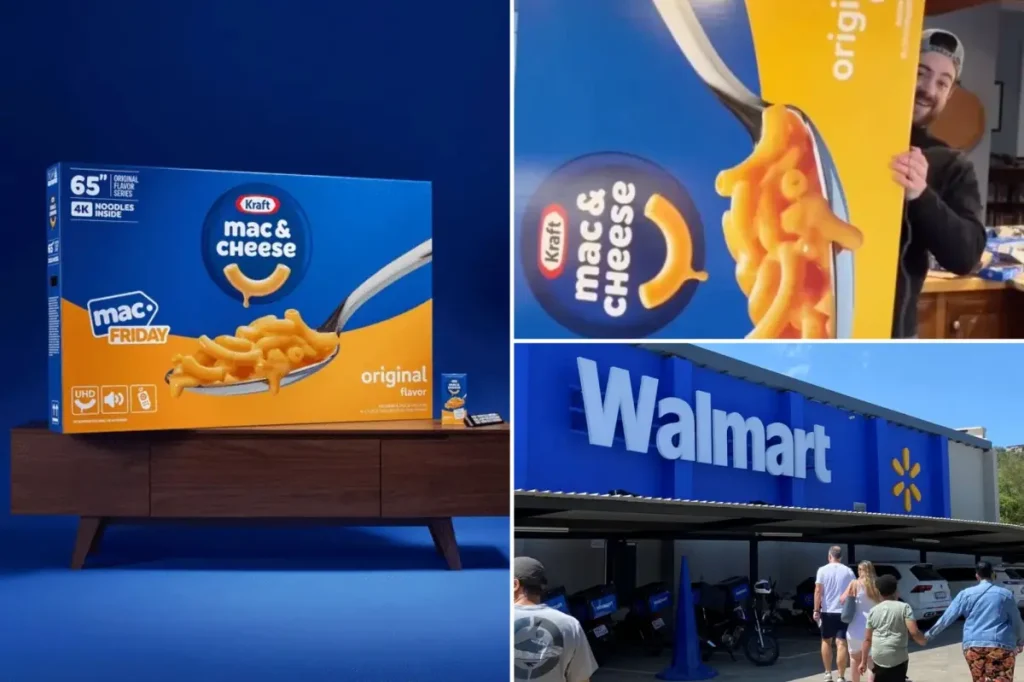Kraft’s Black Friday Box Sparks Shopping Frenzy and Frustration
In a whirlwind of digital clicks and disappointed sighs, Walmart’s Black Friday sale of Kraft’s limited-edition “Mac Friday Box” left thousands of hopeful shoppers empty-handed and increasingly frustrated. The innovative promotional item, cleverly disguised as a 65-inch flat-screen TV box but actually containing 65 boxes of Kraft’s beloved Mac & Cheese, vanished from Walmart’s virtual shelves within seconds of its midnight launch. Priced at a nostalgic $19.37—a deliberate nod to Kraft’s founding year—the box offered an irresistible bargain that worked out to just 30 cents per mac and cheese box, a staggering 76% discount from the regular $1.29 price tag. This intersection of novelty packaging, clever marketing, and genuine value created what many industry observers are calling the perfect storm of Black Friday shopping desire.
The anticipation for this unique offering had been building steadily in the days leading up to Black Friday, fueled by strategic promotion through social media influencers like Zach Ciampa of the popular “Snack with Zach” account. His enthusiastic endorsement described the deal as “one of the best doorbusters of the season by far,” a sentiment that clearly resonated with his followers and mac and cheese lovers nationwide. Kraft’s marketing team had masterfully tapped into several consumer psychology triggers: nostalgia for a comfort food staple, the thrill of limited availability, and the satisfaction of scoring a genuine bargain during America’s most competitive shopping day. The campaign demonstrated how even established brands with everyday products can create buzz and excitement through creative packaging and pricing strategies, particularly when they align with cultural moments like Black Friday.
The human stories behind the failed purchase attempts reveal just how emotionally invested shoppers had become in securing this novelty item. Countless disappointed customers reported staying up until midnight specifically for the release, refreshing their browsers continuously, and even taking elaborate precautions to ensure fast checkout. “I literally had it in my cart and it sold out while I was hitting the finish button—what even,” lamented one shopper, capturing the unique frustration of modern e-commerce where products can disappear during the checkout process itself. Another customer expressed deeper disappointment: “I’m so sad, stayed up for this and I literally have to work tomorrow,” highlighting the real-life consequences of midnight shopping attempts that extend beyond mere product disappointment. These accounts paint a picture of consumers who had emotionally invested in the prospect of this purchase, seeing it as more than just mac and cheese but as a victory, a clever score, or even a collector’s item.
The aftermath of the sellout quickly turned to speculation and cynicism among the disappointed would-be purchasers. Comments across social media platforms revealed a community united in frustration, with one observer noting, “Sounds like no one in the comment section even got a chance to buy one. It’s prob going to resell for hundreds more.” This prediction quickly proved accurate, as by Friday morning, listings for the Mac Friday Box began appearing on resale platforms at dramatic markups, some reaching ten times the original price. The situation highlights an increasingly common pattern in limited-release consumer goods, where items priced for accessibility are quickly converted into resale opportunities—effectively transforming products from their intended purpose into investment vehicles. For Kraft and Walmart, this phenomenon creates a complex brand equation: while the instant sellout generated buzz and demonstrated desirability, it also left their core customers feeling excluded from a promotion specifically designed to reward brand loyalty.
The technical aspects of the release raise questions about the infrastructure supporting such high-demand flash sales. By Friday morning, the product page had completely disappeared from Walmart’s website, replaced with a “We couldn’t find this page” message that offered no explanation or alternative options for interested customers. This abrupt removal of even the digital footprint of the product added to customer frustration, eliminating any possibility of waiting lists or notifications about potential restocks. The experience underscores the growing pains of e-commerce platforms dealing with “hype drops” that generate traffic spikes resembling denial-of-service attacks. Unlike physical retail environments where crowd control measures can be implemented, online flash sales create virtual stampedes that test the limits of even the most robust digital infrastructure, occasionally resulting in poor customer experiences despite successful sales metrics.
The Mac Friday Box phenomenon reveals deeper truths about contemporary consumer culture beyond just one promotional item. It demonstrates how quickly the line between grocery products and collectible items can blur when clever marketing intersects with limited availability. It shows how social media can transform routine purchases into must-have events, creating communities of both successful and disappointed shoppers united by their shared experience. Perhaps most significantly, it illustrates the emotional relationship many consumers have with familiar brands and the disappointment that occurs when access to special promotions feels inequitable. As brands increasingly turn to limited-edition releases and flash sales to generate excitement, they face the challenge of balancing the marketing benefits of scarcity against the potential alienation of loyal customers who miss out. For Kraft, the Mac Friday Box will likely be remembered as both a marketing triumph in terms of attention generated and a cautionary tale about managing consumer expectations in an era where selling out too quickly can sometimes feel like no victory at all.


